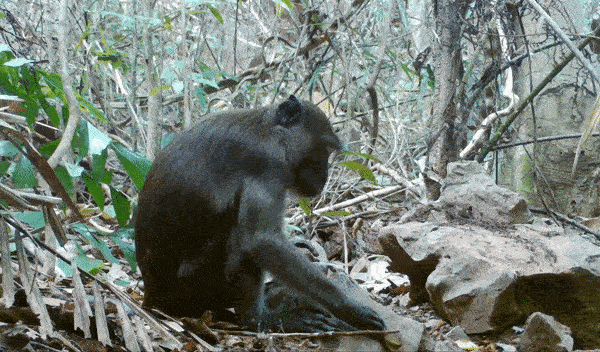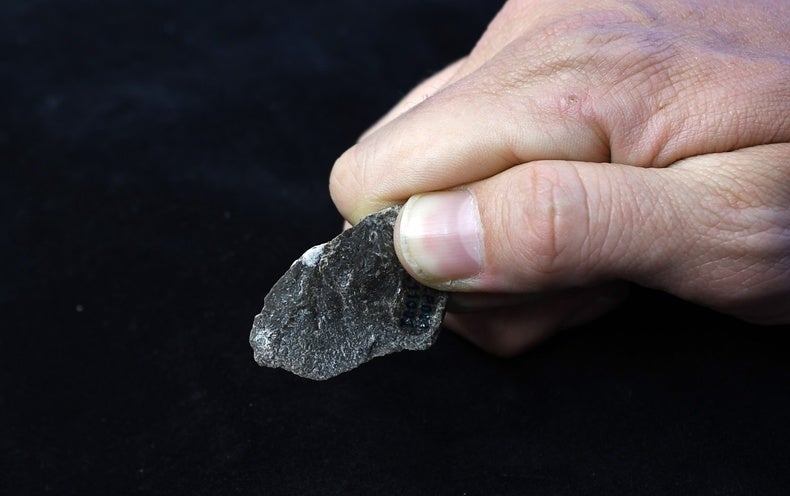Consider the possibility that all human technology started with a mistake—or at least a lack of hand-eye coordination. In pursuit of this idea, Lydia Luncz and Tomos Proffitt, both at the Max Planck Institute for Evolutionary Anthropology in Leipzig, Germany, traveled to an abandoned oil palm plantation near Thailand’s Phang Nga Bay and collected nut-cracking stones used by a resident troop of long-tailed macaques. Macaques bash open oil palm nuts by placing them on a flat stone and striking their shell with another stone. These monkeys often miss the nut and unintentionally break the stones, producing sharp flakes. In a new study, Luncz and Proffitt argue that such mistakenly created flakes may have been our ancient ancestors’ or other now extinct early human relatives’ first step toward creating the sharp-edged tools that they used to butcher animals and cut edible plants. In other words, these are the type of tools that set our species on its evolutionary course to become ever more productive hunter-gatherers and technological tinkerers.
Macaques are one of three modern nonhuman primate species that use stone tools (the other two are chimpanzees and capuchin monkeys). Luncz and Proffitt have been studying the idea that sharp flakes accidentally produced from activities such as nut cracking might have led hominins—a group that includes humans and their extinct ancestors and close relatives—to intentionally make flakes for tools. “This is a completely wild behavior,” Proffitt says. “And it’s a behavior to get food. So in that sense, you can then start to say this could have been a mechanism for the emergence of flake technology.”
For their study, which was published on Friday in Science Advances, the international team of researchers collected more than 1,100 pieces of stone the macaques in Thailand had used to break open oil palm nuts and compared them with archaeological collections from some of the earliest known stone tool sites in Tanzania, Kenya and Ethiopia. Their analysis revealed a surprising fact: The flakes that the macaques unintentionally produced looked a lot like the oldest stone tools that were intentionally made by hominins: Lomekwian and Oldowan stone tool assemblages, which were discovered at sites dating between 3.3 million and 1.5 million years ago. “If we would take the kind of assemblage that we find with the macaques and we would drop them somewhere in East Africa, everybody would think they were definitely made by early hominins,” Luncz says.

Luncz and Proffitt have found similar results with stone flakes produced by capuchin monkeys in Brazil’s Serra da Capivara National Park. “What is super exciting is that we find another primate species on the other side of the world showing us exactly the same phenomenon,” Luncz says. “You don’t need a ginormous large brain to make sharp cutting tools. The challenge is in using the stone tools. I think that’s where the difference lies.” That difference shows up when the collection of macaque tools and flakes are compared with tools from Lomekwian or Oldowan sites. Macaques don’t use the sharp flakes they create for anything, Luncz says, noting that the monkeys have sharp teeth and don’t need cutting tools. The ancient stone tools, however, show evidence of being used for cutting tasks.
“I think this study is useful because it really brings home the point that people need to do careful behavioral interpretation of their artifacts,” says Thomas Plummer, a paleoanthropologist at Queens College, City University of New York, who was not part of Luncz and Proffitt’s team. Plummer is part of a research group that is studying fossil sites in Nyayanga, Kenya. Excavations at those sites, dating to between three million and 2.6 million years ago, have turned up Oldowan tools, as well as two teeth from an extinct species of hominin. The researchers analyzed use-wear patterns on the tools and found that some were employed for pounding and processing plant foods. Some of the flakes also showed damage along their edges, indicating that they had been used for cutting. Cut marks on hippopotamus bones and a fossil of a species of bovine revealed that hominins had used stone tools for butchering the animals, making it clear that the sharp stone tools were anything but unintentional by-products of other pounding activities. That does not necessarily mean those tools were made by a human ancestor, though.
The hominin teeth that were found with Oldowan tools in Nyayanga belonged to a member of the genus Paranthropus, which is on a different branch of the human family tree than the one leading to Homo sapiens. Oldowan tools had been found with Paranthropus at other sites, including the Frida Leakey Korongo Zinj (FLK Zinj) site in Tanzania’s Olduvai Gorge, where the first Paranthropus fossils were discovered. At the time paleoanthropologist Louis Leakey argued that a more direct relative of humans that was found nearby, the slightly larger-brained Homo habilis, must have made the Oldowan tools. And he proposed stone toolmaking as one of the criteria for separating humans from other apes. But evidence from sites such as Nyayanga is starting to point to both Paranthropus and H. habilis being a toolmaker. And the assemblages that macaques and capuchin monkeys create suggest that stone tool use may have begun much earlier in evolutionary history than previously thought. Humans last shared a common ancestor with capuchin monkeys about 35 million years ago and with macaques about 25 million years ago, Luncz says. “I would be surprised if stone tool use was a very new development in the hominin lineage,” she says.
Luncz and Proffitt hope to ultimately learn how primates made the leap from accidentally producing sharp flakes to picking them up and using them. But for the time being, scientists can only speculate. Plummer suggests a scenario in which a group of hominins came across the carcass of an animal and used stones to break open its bones and get at the nutrient-rich marrow: During that process, a hominin missed the bone and knocked a sharp flake loose from the stone it was using. Then that hominin had the idea to use that flake to cut meat from the carcass. “It could be the hominins were just experimenting,” Plummer says.



























































